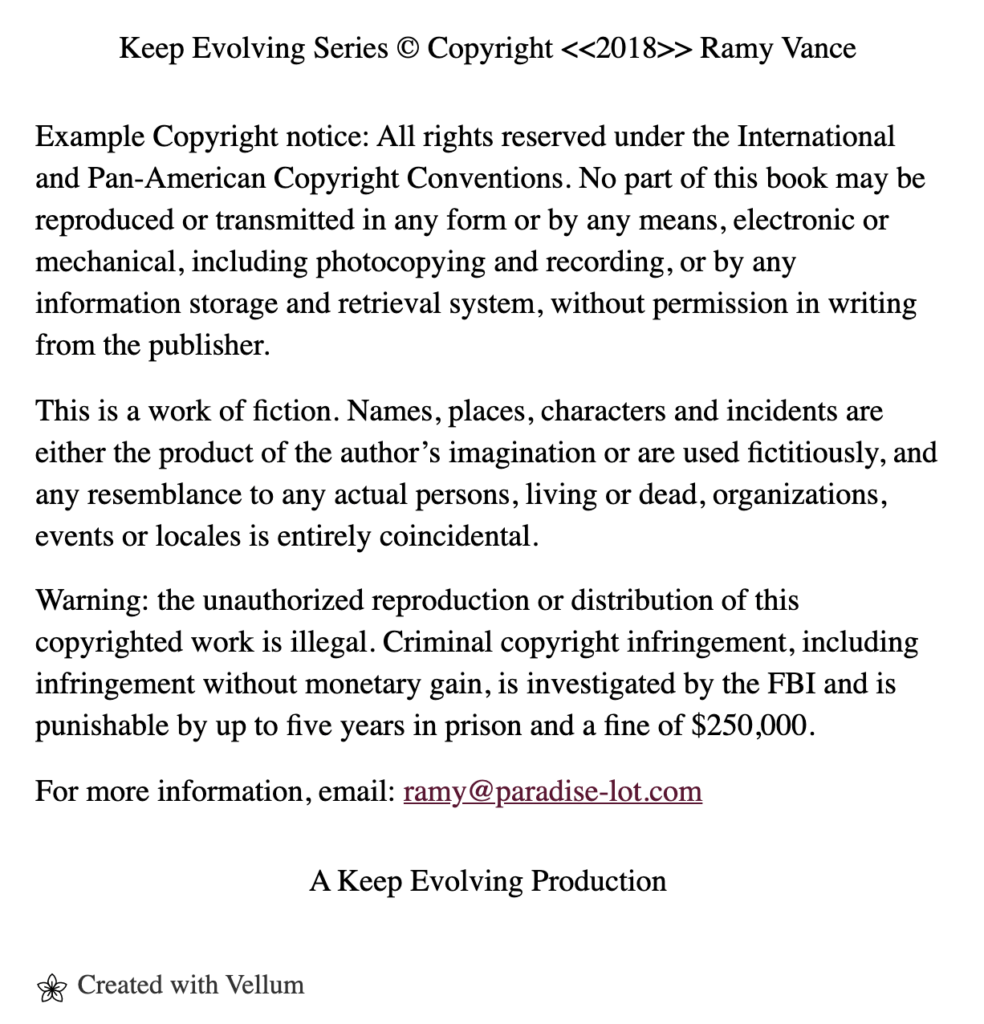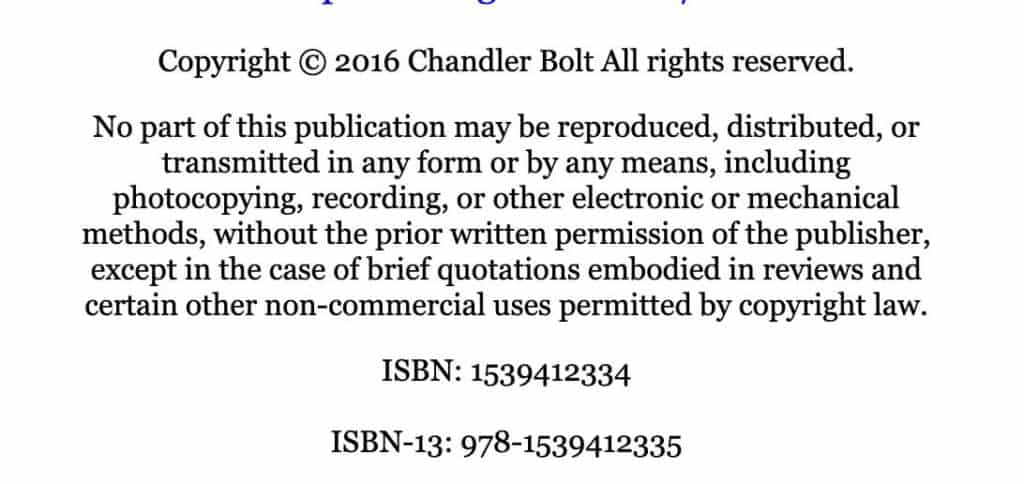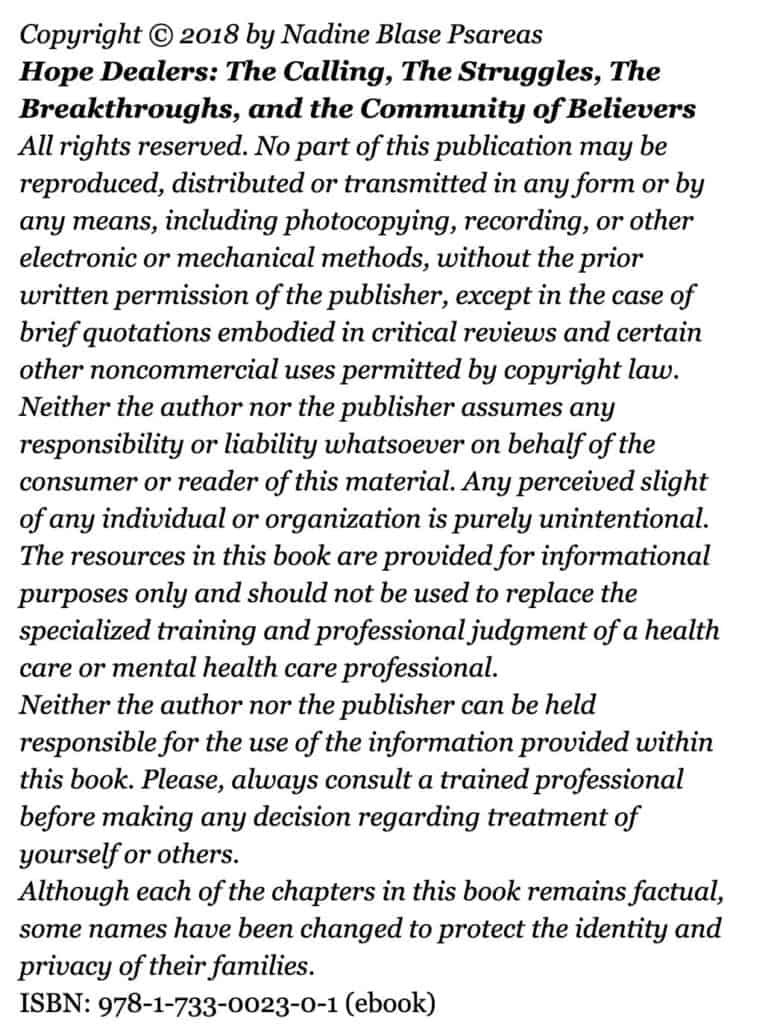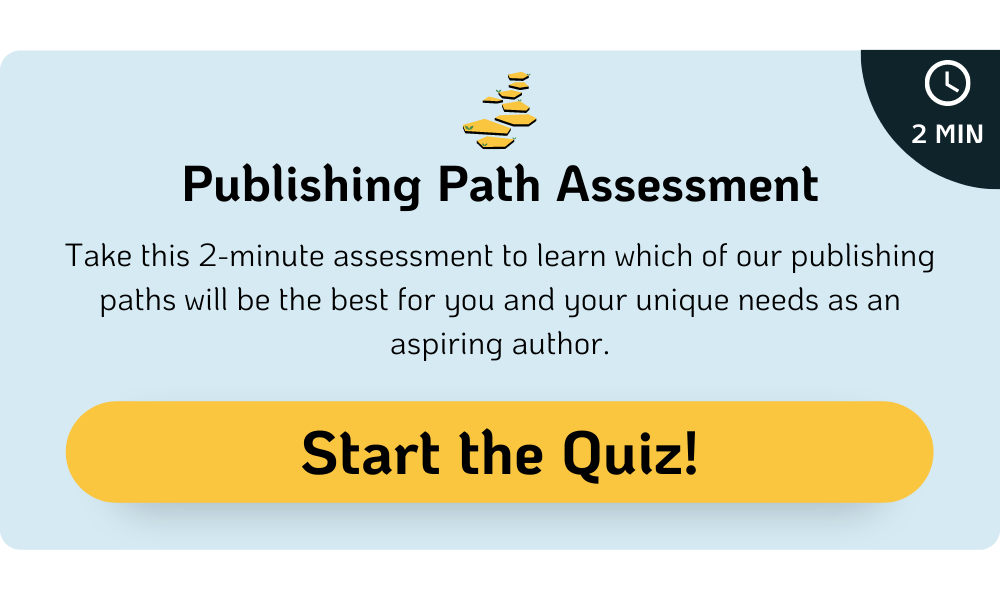Knowing how to copyright a book — the right way — is something that intimidates many authors. With the explosion of self-publishing, authors must be aware of what they can and can’t do when it comes to quoting, borrowing, and publishing works from other authors.
A lot of us get caught up in a confusing haze of copyright laws, infringement, and wondering how to stay out of hot water with the law and angry lawyers (okay, maybe it’s not that dramatic) while also protecting our book babies.
Learning how to copyright a book can help alleviate all of that worry.
Knowing how to copyright a book properly is part of the publishing process, and getting an ISBN number usually follows.
After all, if you get the copyright wrong, someone could steal your work and pass it off as their own. It’s practically an author’s worst nightmare—for good reason.
In this blog, we’ll give you all the information and resources you need to learn how to copyright a book – so you can protect yourself and your work.
We’ll also look at the most frequently asked questions authors ask when it comes to copyright concerns, for both their own works and when borrowing from other sources.
This Blog on How to Copyright a Book Will Cover:
How to Copyright a Book in 10 Minutes
Learning how to copyright a book begins with creating the copyright page in your book.
Every author needs to copyright their book. This process shouldn’t take more than 10 minutes and it’s very easy with our steps.
Here are the steps to copyright a book:
- Go to the Copyright.gov portal
- Scroll down to under “Types of Works” and choose “Literary Works”
- Navigate to “Register a Literary Work” on the left sidebar
- Select either “new user” or login with your account
- If you’re a new user, fill out your information
- Navigate to “Copyright Registration” and select “Register A New Claim”
- Select “Start Registration”
- Fill out the copyright form
- Pay your $85 copyright fee to complete registration
- Submit your finished manuscript to the U.S. Copyright Office
That’s it!
Learning how to copyright a book is much easier than it seems.
Creating Your Copyright Page
The copyright page will appear in your book right after the title page and just before the table of contents. The copyright page needs to include some essential information in order to learn how to copyright a book properly.
The main components of your copyright page are:
- The copyright notice. This has the little © symbol or you can use the word “copyright.” So it would look like this: ©2018 Jane Doe
- The year of publication of the book
- The name of the owner of the works, which is usually the author or publishing house name
- Ordering information
- Reservation of rights
- Book editions
- ISBN Number
- Your website (You need a site where they can learn more about you, your other books, and other opportunities.)
- Credits to the book (book cover designer, editor)
- Disclaimer
Disclaimers For Copyrighting Your Book (By Genre)
When learning how to copyright a book, you may not think you really need a disclaimer. But it’s essential for protecting yourself and others.
So how does a simple sentence or two do this?
If you are writing a book on health and fitness, success as an entrepreneur, or providing financial advice—anything that readers could fail at—an extended disclaimer is something you should seriously consider when learning how to copyright a book.
If you give advice on earning a million dollars this year, and the reader ends up losing money, you could be blamed for their misfortune because of a promise you made.
Consider putting an extended disclaimer in your book that comes after the copyright jargon to protect your opinions, advice, and information.
In other words, tell readers that they are reading your book and applying your advice at their own risk. These disclaimers don’t have to be boring.
On the contrary, the more personality they have, the more likely they are to be read.
Helen Sedwick did a great job collecting examples of authors who got creative with their disclaimers and made their work all the better for it.
Let’s take a look at some specific examples of disclaimers for different types of books.
Fiction Copyright Disclaimer
The typical disclaimer you’ll find in a novel?
“The characters in this book are entirely fictional. Any resemblance to actual persons living or dead is entirely coincidental.”
How could this be “livened” up? See how Tom Wolf in A Man in Full, acknowledges that parts of his story are from real life:
“This novel’s story and characters are fictitious. Certain long-standing institutions, agencies, and public offices are mentioned, but the characters involved are wholly imaginary.“
Or Margaret Atwood in Cat’s Eye tries to dispel readers’ assumption that the book is the alter-ego of the writer:
“This is a work of fiction. Although its form is that of an autobiography, it is not one. Space and time have been rearranged to suit the convenience of the book, and with the exception of public figures, any resemblance to persons living or dead is coincidental. The opinions expressed are those of the characters and should not be confused with the author’s.“
If you’ve written about a prominent figure that people might be familiar with and don’t want confusion over whether you’re now writing history or still sticking with fiction, you can approach it similar to D. M. Thomas dealt with using Freud as a character in The White Hotel:
“The role played by Freud in this narrative is entirely fictional. My imagined Freud does, however, abide by the generally known facts of the real Freud’s life, and I have sometimes quoted from his works and letters, passim. The letters . . . and all the passages relating to psychoanalysis . . . have no factual basis.“
Here’s an example of what your book copyright page would look like for a fiction book.

Nonfiction Copyright Disclaimer
When learning how to copyright a book, keep in mind that a nonfiction disclaimer will look different from a fiction one. Here is an example:
“The advice and strategies found within may not be suitable for every situation. This work is sold with the understanding that neither the author nor the publisher are held responsible for the results accrued from the advice in this book.“
However, Rebecca Skloot’s The Immortal Life of Henrietta Lacks found a way to get her disclaimer to speak to the honesty of the text:
“This is a work of nonfiction. No names have been changed, no characters invented, no events fabricated.“
When learning how to copyright a book, a nonfiction book copyright page looks like this:

Memoir Copyright Disclaimer
The typical disclaimer you’ll find in memoirs?
“This book is a memoir. It reflects the author’s present recollections of experiences over time. Some names and characteristics have been changed, some events have been compressed, and some dialogue has been recreated.”
But in This Boy’s Life by Tobias Wolf, he buries his disclaimer in his acknowledgments. As he thanks those who read drafts of the book, he says:
“I have been corrected on some points, mostly of chronology. Also my mother claims that a dog I describe as ugly was actually quite handsome. I’ve allowed some of these points to stand, because this is a book of memory, and memory has its own story to tell. But I have done my best to make it tell a truthful story.“
This is what a copyright page looks like from our own student, Nadine Blase Psareas’s memoir Hope Dealers, that you can emulate if you’re writing a memoir:

Legal Terms to Know When Learning How to Copyright a Book
I know, I know…we would rather write books, rake in the cash, and sign autographs than worry about technical legal jargon.
I get it. It can seem boring, but the better you understand how copyright law works, the more time you can spend writing without wondering, “Is this legal?”
Here are some legal terms to keep you informed on your rights as a self-publisher and protect your works:
- Copyright infringement: is the use of works protected by copyright law without permission, infringing certain exclusive rights granted to the copyright holder, such as the right to reproduce, distribute, display or perform the protected work, or to make derivative works. The copyright holder is typically the work’s creator, or a publisher or other business to whom copyright has been assigned. Copyright holders routinely invoke legal and technological measures to prevent and penalize copyright infringement when learning how to copyright a book.
- Intellectual property (or “IP”): is a category of property that includes intangible creations of the human intellect, and primarily encompasses copyrights, patents, and trademarks. It also includes other types of rights, such as trade secrets, publicity rights, moral rights, and rights against unfair competition. Artistic works like music and literature, as well as some discoveries, inventions, words, phrases, symbols, and
designs can all be protected as intellectual property. - Public Domain Work: refers to works whose exclusive intellectual property rights have expired, have been forfeited, have been expressly waived, or are inapplicable. For example, the works of Shakespeare and Beethoven, and most early silent films are in the public domain either by virtue of their having been created before copyright
existed, or by their copyright termhaving expired.
Some works are not covered bycopyright, and are therefore in the public domain—among them the formulae of Newtonian physics, cooking recipes, and all computer software created prior to 1974. Other works are actively dedicated by their authors to the public domain; some examples include reference implementations of cryptographic algorithms, the image-processing software ImageJ, created by the National Institutes of Health, and the CIA’s World Factbook.
The term public domain is not normally applied to situations where the creator of a work retains residual rights, in which case use of the work is referred to as “under license” or “with permission”. - Plagiarism: is the “wrongful appropriation” and “stealing and publication” of another author’s “language, thoughts, ideas, or expressions” and the representation of them as one’s own original work. When learning how to copyright a book, it’s important to avoid plagiarism.
- First Amendment (Amendment I): to the United States Constitution prevents Congress from making any law respecting an establishment of religion, prohibiting the free exercise of religion, or abridging the freedom of speech, the freedom of the press, the right to peaceably
assemble, or to petition for a governmental redress of grievances. It was adopted on December 15, 1791, as one of the ten amendments that constitute the Bill of Rights. - Fair use: in its most general sense, a fair use is any copying of copyrighted material done for a limited and “transformative” purpose, such as to comment upon, criticize, or parody a copyrighted work. Such uses can be done without permission from the copyright owner. In other words, fair use is a defense against a claim of copyright infringement. If your use qualifies as a fair use, then it would not be considered an infringement.
- Libelous writing: can be personal libel or trade libel, which is also known as “product disparagement.” Product disparagement can include a product, service or entire company. Libelous statements, whether against persons or products, are published statements that are false and damaging.
Slander is the same as libel in moststates, but in spoken rather than written form. The terms “libel” and “slander” are often subsumed under the broader term “defamation.” It is a tort (a wrongful act) to harm another’s reputation by defaming them. You should avoid this when learning how to copyright a book.
Before you publish your next book, take a few minutes to read over this “brief” report from the United States Copyright Office.
You can also check out this handy guideline for authors from Wiley on what needs permission vs. what you can use without asking when learning how to copyright a book.
When in doubt, consult with legal counsel or take the time to research the material you are either protecting or planning to borrow from another source. The time invested when learning how to copyright a book could save you an embarrassing or costly situation down the road.
Knowing what you can and shouldn’t do is a critical part of the publishing business.
When you write and publish your own works, you are now in business for yourself, and business owners protect their property by learning how to copyright a book the right way. Don’t make things harder for yourself!
FAQs About How to Copyright a Book
Nowadays, with the massive expansion of self-publishing, it is more important than ever for authors, artists, and creatives putting their work out there to know how to copyright a book.
When we borrow work from other authors, living or dead, we have to consider:
- What can I actually use?
- When is permission needed?
Here is the golden rule when it comes to copyright laws: Never assume that anything is free!
Everything out there, including on the internet, has been created by someone. Here are common questions authors have about protecting themselves, their works, and others they may have quoted in their books:
Do I have to register my book before it is copyrighted?
Your book is legally copyrighted as soon as it is written.
But, to scale up your legal rights and protect your material to the fullest extent, you should register your book with the Federal Copyright Office when learning how to copyright a book.
On the chance someone does attempt to pirate your book or portions of it, registering with the US Copyright Office will give you greater leverage if it comes to action being taken.
How many words can I quote from another book or source?
Generally speaking, there are no set rules on how much you can actually “borrow” from existing works. But, it’s best to exercise common sense here and keep it short, as a general rule under 300 words.
Paul Rapp, a lawyer specializing in intellectual property rights, says, “If the quote drives your narrative, if you are using an author’s quote in your argument, or if you are giving an opinion on an author’s quote, then it is considered fair use.”
What is fair use? It’s a legal concept that allows the reproduction of copyrighted material for certain purposes without obtaining permission and without paying a fee or royalty. Purposes permitting the application of fair use generally include review, news reporting, teaching, or scholarly research.
If you use something published by someone else with the sole purpose of monetary gain, this doesn’t constitute fair use.
Can I write about real people?
Especially in works of nonfiction, real people are often mentioned to express an opinion or as an example to clarify the writer’s fact or opinion. Generally, you can use the names of real people as long as the material isn’t damaging to their reputation or libelous.
When learning how to copyright a book properly, stick to the facts and write about what is true based on your research.
Can I borrow lyrics from songs?
Stephen King often used song lyrics for his books, including Christine and The Stand. He obtained permission for these works. King says, “Lyrics quotes in this book [Christine] are assigned to the singer most commonly associated with them. This may offend the purist who feels that a song lyric belongs more to the writer than the singer.”
Basically, song lyrics fall under strict copyright even if it is just a single line used. When learning how to copyright a book, try to get permission if you use a song.
You can contact the American Society of Composers, Authors and Publishers (ASCAP) or Broadcast Music, Inc. (BMI). Once you find the rights owner, you have to ask for permission through writing.
Do I need permission to borrow material from a book that is over 100 years old?
Once the copyright on a book or material has expired, or the author has been dead for seventy years, the work enters into the public domain and you can use it without permission or licensing.
BUT this does vary from country to country. When learning how to copyright a book, you should check with your local copyright office.
You can check the copyright office in the US here.
Are authors liable for content used in a book?
Yup.
Even with traditional publishing houses, the author is still responsible for the content written and used in the book.
In fact, traditionally published authors usually have to sign a waiver that removes the publisher from any liability pertaining to the material the author used if the writer included that material without proper permission. Which means it’s still super important to know how to copyright a book.
And you already know, if you go the self-publishing vs traditional publishing route, you’re on your own.
If I use an inspirational quote from another writer or famous person, do I need permission?
You don’t need permission to use quotes in a book provided that you credit the person who created it and/or spoke the quote.
For example: “Is all that we see or seem but a dream within a dream” – Edgar Allan Poe
What is the best way to protect my work from being stolen?
Your work is copyrighted as soon as it is written.
But to protect yourself further when learning how to copyright a book, you can register your work with the US copyright office.
If you have a blog where you also post content, you need to have a Terms & Privacy disclaimer on your page. This would preferably be at the top where it is easy to see, although many writers and bloggers include this at the bottom of every page.
You should also include your Copyright on your blog that protects your content from being “copied and pasted” into another site without permission or recognition.
A royalty-free stock photo means that I can use it for free and don’t have to get permission, right?
Wrong.
Most stock photos are copyrighted, even if they appear in search engines and we can easily download or copy them.
If you grab a photo off the net and think you can slap it on a book cover or use it for free in your book, think again.
It’s recommended you purchase photos through sites such as Shutterstock or Depositphotos.
Copyright With Confidence
Have more questions about how to copyright a book? The team at Self-Publishing School is happy to help you learn all you need to know about writing, copyrighting, and publishing your next bestseller. Take the quick quiz below to see what services could help you most.
